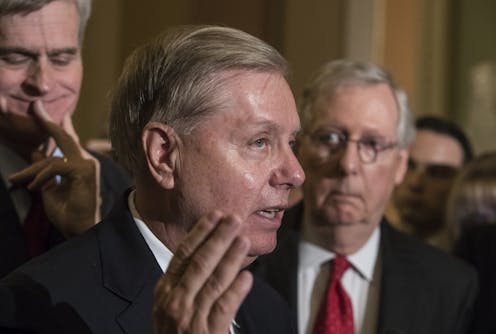How Obamacare has helped poor cancer patients
Poor people who have cancer are one of the most financially vulnerable groups in the US. Obamacare aimed to improve their access to care. A recent study shows how it did.

Two weeks ago, Senate Majority Leader Mitch McConnell pulled the vote for the latest measure to repeal the Affordable Care Act (ACA).
Cancer patients across the U.S. likely breathed a sigh of relief with the knowledge that, at least for now, they no longer had to fear losing essential health benefits or being denied coverage due to a preexisting condition. But the effort to repeal continues.
I am a radiation oncologist who studies the gaps in care between rich and poor and those who have access and those who don’t. Cancer changed my life when it claimed my husband’s. We had health insurance, but even standard coverage is often not enough with cancer. Imagining how those without insurance could possibly manage, I ended up in medical school to learn how to treat cancer and also how to address coverage gaps.
My colleagues and I recently completed the first study to show that the ACA narrowed the gap for cancer patients who are poor.
Cancer and uninsurance
The ACA fundamentally changed the insurance landscape in the U.S.
When the ACA was passed in 2010, 16.3 percent of the U.S. population was uninsured. Being uninsured is never good, but it’s particularly bad for cancer patients. It can affect their survival. It also can wreck their finances and that of their families.
Uninsured patients with cancer are more likely to be diagnosed later and have advanced stages of disease. They’re significantly less likely to receive the most effective cancer treatments, including radiation therapy and surgery. Uninsured cancer patients are also more likely to die of their disease.
Due to a 2012 Supreme Court ruling, individual states were allowed to choose whether to expand Medicaid as intended under the ACA. Expansion gave families with limited income – up to 133 percent of the federal poverty level – access to government health care. To date, 32 states, including the District of Columbia, have opted to expand Medicaid in some way.
Rates of uninsured cancer patients dropped
Our study evaluated the actual effects of the 2014 Medicaid expansion under the ACA by focusing on real patient data from cancer patients treated for their disease within the first year of expansion. The Surveillance, Epidemiology and End Results Program database is maintained by the National Cancer Institute and represents an authoritative source on cancer incidence and survival in the United States.
We examined the records of almost 200,000 adult cancer patients who received radiation treatments for cancer from 2011 to 2014. We looked at changes in insurance status, comparing the years immediately prior to expansion to the year of expansion.
We also specifically assessed differences between states that fully expanded Medicaid according to ACA guidelines versus those that chose to not expand.
Overall, we found uninsurance rates dropped significantly across both expanded and nonexpanded states. However, uninsurance rates dropped far more in states with full expansion.
States that expanded Medicaid cut the rate of uninsured cancer patients receiving radiation by more than 50 percent. In states that did not expand Medicaid, the rate of uninsurance decreased by a relative 5 percent.
In states that had expanded Medicaid, the proportion of Medicaid recipients rose from 15.2 to 18 percent. In states that did not expand Medicaid, Medicaid coverage dropped by one point.
Disparities in care
Our study also found that there were already significant baseline differences in care and coverage across states.
Before the ACA was in effect, states that did not expand Medicaid had over twice the rate of uninsured cancer patients. They also had a much higher rate of patients living in the areas of highest poverty.
The 2014 Medicaid expansion aimed to increase coverage for all populations, but particularly for the poor. That appeared to work: The states that expanded Medicaid saw uninsurance rates for those cancer patients living in the poorest areas drop by 60 percent.
But in states that did not expand Medicaid, the benefits primarily went to white patients and those living in areas of relative wealth. We saw no improvements in uninsured rates for black patients and residents of high-poverty areas in the states that did not expand.
These populations in the nonexpanded group likely represent people who could buy private health insurance on the health care exchanges that were established by the ACA. It’s unclear whether these patients would have qualified for Medicaid expansion in the first place.
It appears that full Medicaid expansion really did most benefit those at highest risk for gaps in health care, such as African-Americans and the poor. In states that did not expand Medicaid, these at-risk populations only saw their insurance coverage worsen during the study period.
Why this matters so much
High rates of uninsurance can create a “spillover” effect, resulting in reduced health care quality for insured patients living in the same community.
The ACA helped increase insurance coverage, but it clearly isn’t perfect. Research shows that patients with Medicaid may fare worse than those with non-Medicaid insurance, although it can be difficult to separate their cancer outcomes from relevant social factors such as poverty, education and access.
There are also potential coverage gaps under the ACA, as only 41 percent of plans include in-network access to a NCI Designated Cancer Center. These treatment facilities undergo rigorous screening to receive research funding for clinical trials that can result in treatment advances and greater understanding of the disease.
More research is needed to better understand specific changes in access, health care delivery and quality of care under the ACA. We still need to evaluate whether the changes in insurance coverage seen will affect cancer survival.
The debate over health care reform is ongoing. Regardless of the recent demise of Graham-Cassidy – the fourth ACA repeal bill this year – there are legislative legs for at least a substantive reform of the ACA, if not direct repeal. Studies such as ours, which show a clear benefit in insurance coverage changes for our most vulnerable populations, provide essential information in this debate.
Fumiko Chino does not work for, consult, own shares in or receive funding from any company or organization that would benefit from this article, and has disclosed no relevant affiliations beyond the academic appointment above.
Read These Next
Sleep problems and depression can be a vicious cycle, especially during pregnancy − here’s why it’s
Inadequate sleep can have negative downstream effects on everyday cognitive functioning and mental health,…
Donor-advised funds have more money than ever – and direct more of it to politically active charitie
When foundations make grants to DAFs, the digital trail normally created instead becomes a dead end.
How a niche Catholic approach to infertility treatment became a new talking point for MAHA conservat
Mainstream medical organizations have criticized ‘restorative reproductive medicine,’ but some Catholics…






